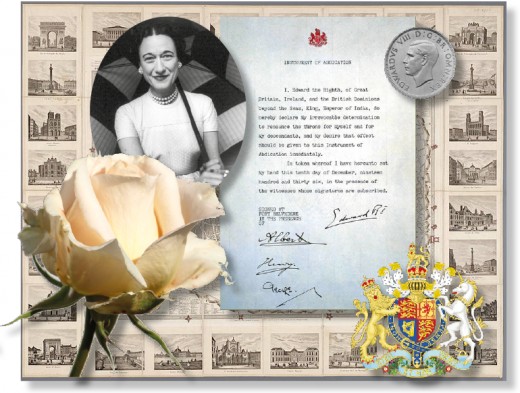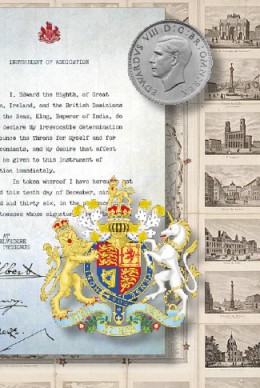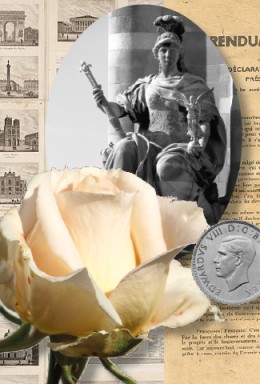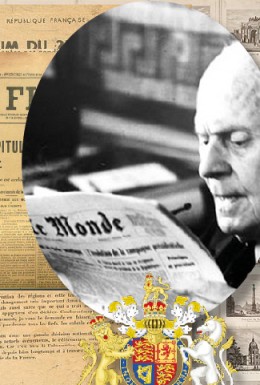What happened to Wallis Simpson after the Duke of Windsor died?
Wallis was of course, the Duchess of Windsor. Her husband the duke had formerly been King Edward VIII and famously he abdicated in 1936 so that he could marry her. Their affair and subsequent marriage had tongues wagging on both sides of the Atlantic and was the constitutional crisis of the twentieth century.
They had a curious, scandalous and rather sad married life but when the duke died and left her a widow, things became even more mysterious. Learn more about this strange and bizarre story.

King Edward had been unable to marry Wallis and remain king because not only was she American – and kings were expected to select their brides from their own country – but also because she was on her second marriage when their affair began. The country and the commonwealth would not accept a woman as queen who had been divorced twice.
So the king gave up this throne so that he could marry her and they were given the titles of the Duke and Duchess of Windsor. As war with Germany was looming, they were also considered persona non grata in Britain because of their Nazi sympathies. They were no longer welcome to live in England. During the war, the Duke was given the rather insignificant post of governor of the Bahamas, largely to keep him out of the way. After the war, they led a rather nomadic existence, finally settling in Paris.
They had no children and when the duke died in 1972, Wallis remained in their Paris home and was soon considered to be a recluse.
Wallis the widow
 Eight years after the duke died, the editors of the Sunday Times in London decided that their readers would like to know more about the current life of the woman who had caused so much scandal and disruption in the 1930s.
Eight years after the duke died, the editors of the Sunday Times in London decided that their readers would like to know more about the current life of the woman who had caused so much scandal and disruption in the 1930s.
They commissioned society photographer Lord Snowdon to travel to Paris as this would be a largely visual article. But it also needed some copy so journalist Caroline Blackwood to write the piece.
The duchess was by now in her mid-eighties. Her exact year of birth was in some doubt because it was suggested that she had been born before her patents were married so falsified her birth year.
No-one really knew anything about her recent life or the current state of her health. There were rumours that she was bedridden and others that she had Alzheimer’s disease. Like much of her life, it was a mystery.
But the truth turned out to be very strange indeed.
Enter Maitre Suzanne Blum
 Caroline Blackwood travelled to Paris to interview Wallis. She was told that the interview would be arranged through the duchess’ lawyer, Suzanne Blum. SO Caroline made an appointment to visit the lawyer to arrange her meeting with the duchess.
Caroline Blackwood travelled to Paris to interview Wallis. She was told that the interview would be arranged through the duchess’ lawyer, Suzanne Blum. SO Caroline made an appointment to visit the lawyer to arrange her meeting with the duchess.
Maitre Blum was an old lady – almost as old as the duchess. But she was formidable. Caroline Blackwood discovered that at some time after the duke had died the lawyer had acquired the duchess’ power of attorney and ruled every aspect of her life.
She told the journalist that under no circumstances could she visit or interview the duchess. She also told Caroline that she was not to write on single derogatory word about the duchess – ever.
At this point Caroline realised how serious the lawyer was about protecting the duchess’ privacy.She realised it all the more when Maitre Blum blithely told her that she would kill her if she wrote one bad word about her client.
But Caroline didn’t give up
 Maitre Blum had meant it when she said that she would kill Caroline. But the journalist was now intrigued and wanted to understand why. She decided to meet the duchess’ friends and find out more.
Maitre Blum had meant it when she said that she would kill Caroline. But the journalist was now intrigued and wanted to understand why. She decided to meet the duchess’ friends and find out more.
The first person she spoke to was Lady Mosley, formerly Diana Mitford. Lady Diana and her husband were old friends of the Windsor’s, they were also exiled from Britain and had made their home in Paris near to the Windsor residence.
Diana told her that she and other friends of the duchess had come across similar treatment from Maitre Blum. They had tried to see Wallis but had been prevented from doing so.
Diana and Wallis had been close. Caroline realised that this was a strange situation and went on to talk to other people who were friends of the duchess. They all confirmed the story – that over the last few years they had tried to see Wallis but Maitre Blum stood in their way.
Back to Maitre Blum
Cautiously, Caroline had a further series of meetings and telephone calls with the lawyer. There was still no chance of her seeing the duchess, she was told. And Maitre Blum was inconsistent in her story. Sometimes she told Caroline that the duchess was frail but in relatively good health and lived a pleasant, quiet life.
At other times she was told that the duchess was in a coma being carefully tended by a medical team.
A Spanish photographer became aware of Caroline’s investigations and got in touch with her.He showed her photographs that he claimed he’d taken using a telephoto lens. They showed the duchess in her bedroom in a vegetative state. She was stick thin and seemed to be unconscious. Were these genuine? There’s no way of knowing.
But the next time Caroline contacted Maitre Blum,she was told that the duchess was well and content with her quiet life.
Jewellery
Caroline then discovered that the lawyer had been selling the duchess’ jewellery and valuable possessions. She had power of attorney after all, but she was selling these goods secretly. Caroline did not dare challenge the fearsome lawyer about this but was convinced that it was true. Was Maitre Blum defrauding Wallis or was she using the money to pay for the duchess’ medical care? The lawyer had complete control.
Georges and the Baron
 Caroline then heard that one of the duchess’ old friends, an Austrian baron, had seen Wallis. He claimed that two years previously, he had received phone call from the duchess who was clearly upset and wanted to know why all her old friends had abandoned her when the duke died.
Caroline then heard that one of the duchess’ old friends, an Austrian baron, had seen Wallis. He claimed that two years previously, he had received phone call from the duchess who was clearly upset and wanted to know why all her old friends had abandoned her when the duke died.
The baron, who like others had tried to see the duchess, was disturbed by this. He too had been prevented from seeing her by the old lawyer. He travelled to Paris, determined to see the duchess so went straight to her home. Her servant, Georges, totally forbade him to enter the house.
He referred him to Maitre Blum. The baron used his every power of persuasion but couldn’t get to see the duchess. Some months later though, still worried, he tried again. What secret weapon, bullying tactics or threat he used we’ll never know but he was allowed a mere glimpse of the duchess in her home. He was permitted to look through her bedroom door. What he saw horrified him. The duchess was tiny and curled into a foetal position. She was unconscious and the thing he found to be even more horrific was that her skin was wrinkled and so dark that she looked like ‘a prune’.
Then Caroline was asked a question that chilled her to the bone. During her investigations she met a wealthy Frenchman who told her that he had been approached by someone trying to sell him some valuable goods that had belonged to the late duke. Caroline told him what she had discovered. The man was horrified by her stories and mentioned that he had a friend who was a private investigator. He introduced Caroline to him. When they met, and she recounted her stories, he asked:
“How do you know that the duchess is still alive?”
Caroline then realised – she didn’t know. No-one, apart from the baron, had seen the duchess in recent months. And even then, he only glimpsed a shrivelled (almost mummified), motionless creature. The investigator went onto explain that it was relatively common in France to conceal deaths when large sums of money, wills or trust funds were involved.
Officially the duchess died on 24th April, 1986.
You can read about Caroline’s investigations into the later life of the Duchess of Windsor in her book which is on Amazon. The book is out of print now so used hardback and paperback copies are available for pennies. It’s an enthralling read.
FURTHER READING:



December 11, 2016
Since Caroline’s life had been threatened and no-one had seen the Duchess for some time surely the police should have been informed. I realise those were different times but even then if a crime had been reported (threatening behaviour towards Caroline or possible foul play re the Duchess) it would have been investigated especially considering who the Duchess was.